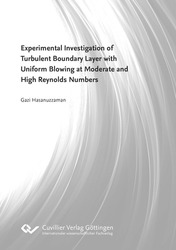| Departments | |
|---|---|
| Book Series (96) |
1378
|
| Nachhaltigkeit |
3
|
| Gesundheitswesen |
1
|
| Humanities |
2364
|
| Natural Sciences |
5406
|
| Engineering |
1793
|
| Engineering | 292 |
| Mechanical and process engineering | 862 |
| Electrical engineering | 686 |
| Mining and metallurgy | 30 |
| Architecture and civil engineering | 75 |
| Common |
98
|
|
Leitlinien Unfallchirurgie
5. Auflage bestellen |
|
Advanced Search
Experimental Investigation of Turbulent Boundary Layer with Uniform Blowing at Moderate and High Reynolds Numbers (English shop)
Gazi Hasanuzzaman (Author)Preview
Extract, PDF (830 KB)
Table of Contents, PDF (34 KB)
Experimental investigation in turbulent boundary layer flows represents one of the canonical
geometries of wall bounded shear flows. Utmost relevance of such experiments, however,
is applied in the engineering applications in aerospace and marine industries. In particular, continuous effort is being imparted to explore the underlying physics of the flow in order to develop models for numerical tools and to achieve flow control. Flow control experiments have been widely investigated since 1930’s. Several flow control technique has been explored and have shown potential benefit. But the choice of control technique depends largely on the boundary condition and the type of application.
Hence, friction drag of subsonic transport aircraft is intended to be reduced within the scope of this Ph. D. topic. Therefore, application of active control method such as microblowing effect in the incompressible, zero pressure gradient turbulent boundary layer was investigated. A series of experiments have been performed in two different wind tunnel facilities. Wind tunnel from Department of Aerodynamics and Fluid Mechanics (LAS)was used for the measurements for moderate Reynolds number range in co-operation with the wind tunnel from Laboratoire de M´ecanique de Feiret Lille for large Reynolds number range. Measurements are conducted with the help of state-of-the-art techniques
such as Laser Doppler Anemometry, Particle Image Velocimetry and electronic pressure sensors.
| ISBN-13 (Hard Copy) | 9783736975583 |
| ISBN-13 (eBook) | 9783736965584 |
| Final Book Format | A5 |
| Language | English |
| Page Number | 180 |
| Lamination of Cover | matt |
| Edition | 1. |
| Publication Place | Göttingen |
| Place of Dissertation | Cottbus-Senftenberg |
| Publication Date | 2022-01-18 |
| General Categorization | Dissertation |
| Departments |
Technical mechanics
Mechanical and process engineering |
| Keywords | Drag reduction, Friction drag, Laser Doppler Anemometry (LDA), Particle Image Velocimetry (PIV), Turbulent Boundary Layer (TBL), Micro-Ausblasen, Laser-Doppler-Anemometrie, Reibungswiderstand, Turbulente Grenzschicht, Windkanal, Strömung, Strömungskontrolle, Unterschall-Transportflugzeug, Effekt des Mikro-Ausblasens, Reynoldszahl, Drucksensor, wind tunnel, subsonic transport aircraft, Reynolds number, Prandltsche Mischlängenhypothese, Prandlt's mixing length hypothesis, Van Driest-Profil, Van Driest profile, Sutherland-Korrektur, Sutherland's correction, Wandschubspannung, wall shear stress, dynamic viscosity, dynamische Viskosität, Wärmekonvektion, heat convection, Flugzeugkomponenten, aircraft component, Flugobjekte, flying objects, allgemeine Luftfahrt, general aviation, Geschwindigkeitsverteilung, streamwise velocity, viskose Teilschicht, viscous sub-layer, Turbulenzfluktuation, turbulence fluctuation, kinetischer Turbulenzenergie, turbulence kinetic energy, mikroperforierte Oberfläche, micro-perforated surface, Heckteil, tail section, Reynolds-Schubspannung, Reynolds Shear Stress, äußere skalierte Geschwindigkeitsdefekt-Profile, outer scaled velocity defect profiles, Wand-Normalgeschwindigkeitsfluktuationen, wall-normal velocity fluctuations, Luftfeuchtigkeit, Schichtdicke, layer thickness, displacement thickness, momentum thickness, Impulsdicke, Verdrängungsdicke, |








